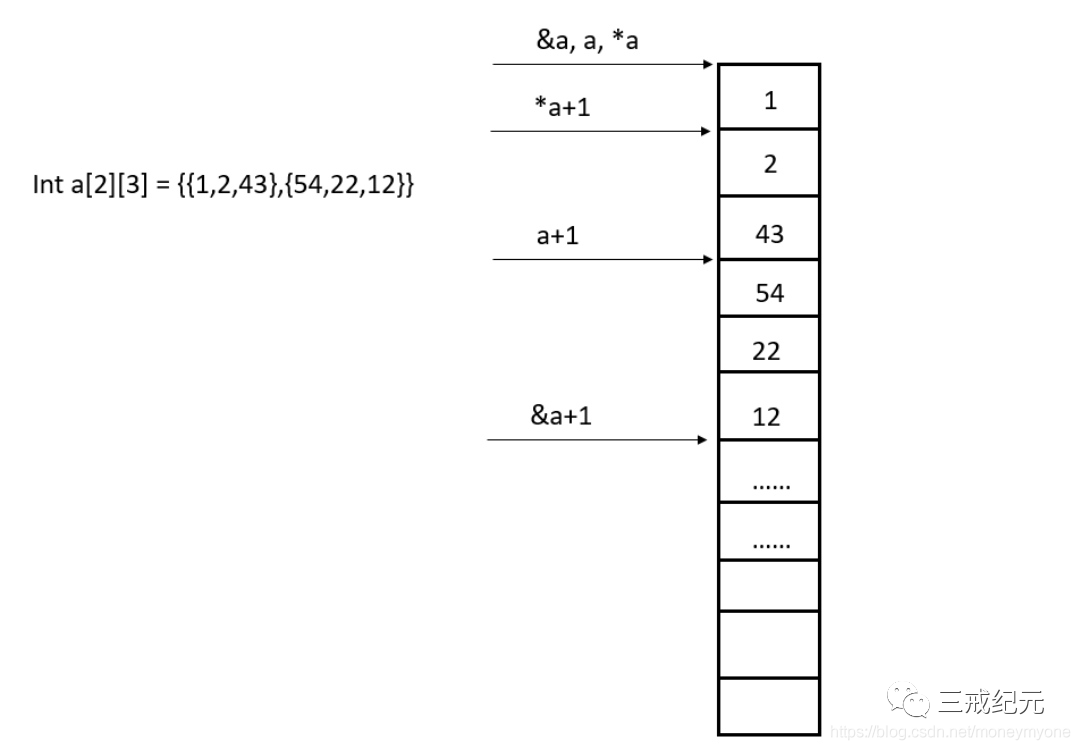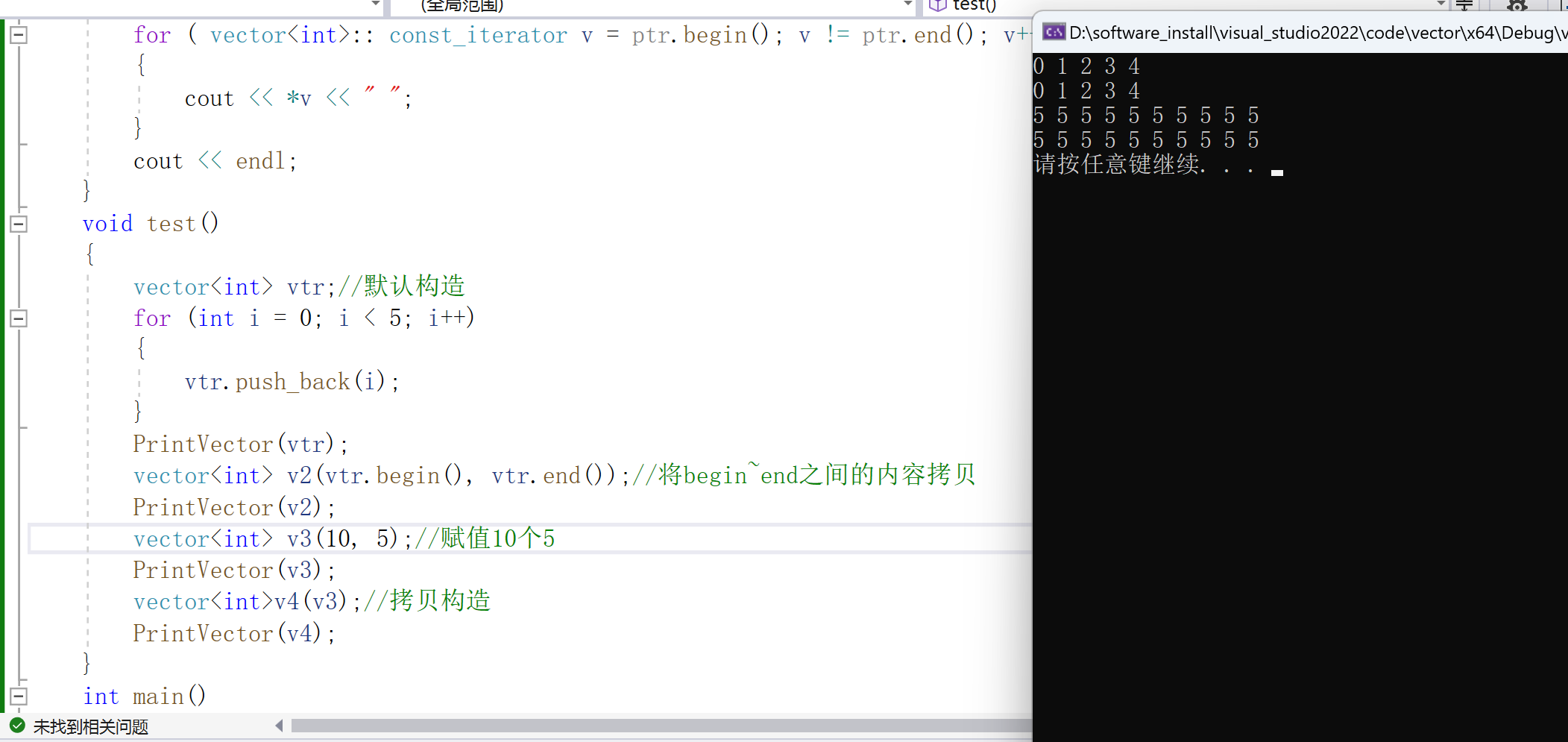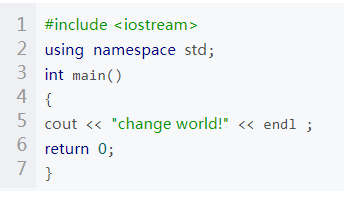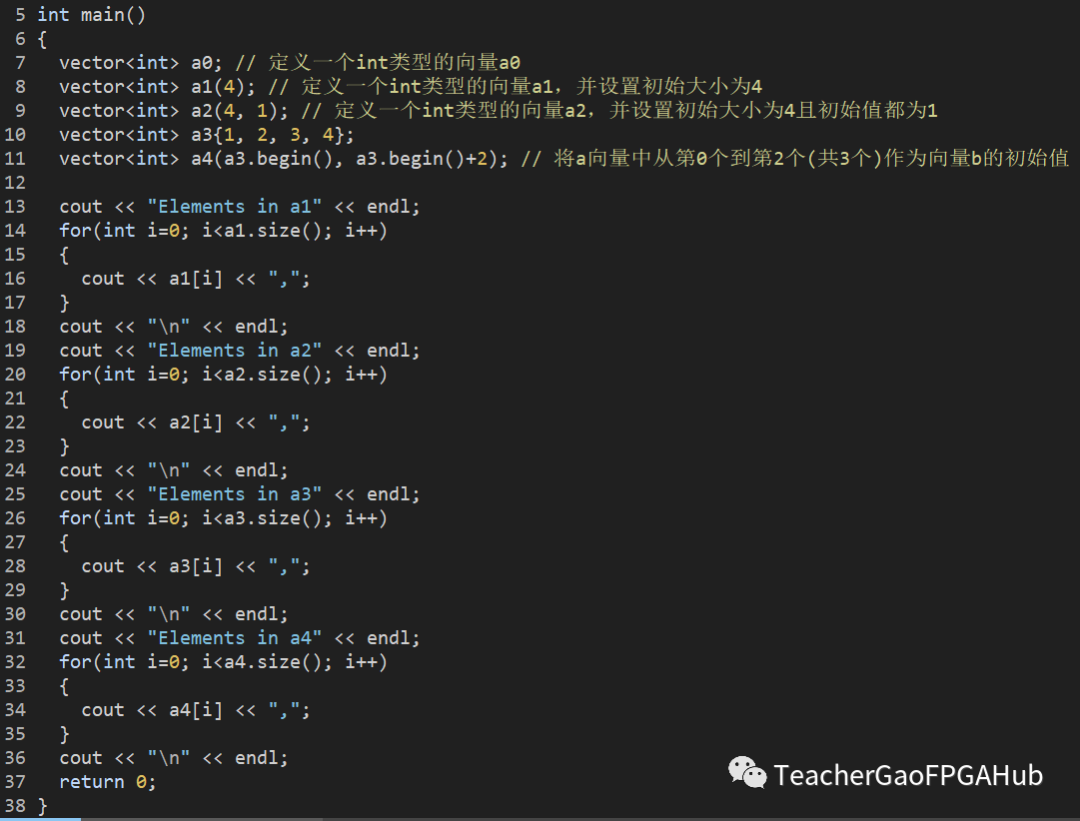1. std::vector
std::vector是C++的默认动态数组,其与array最大的区别在于vector的数组是动态的,即其大小可以在运行时更改。std::vector是封装动态数组的顺序容器,且该容器中元素的存取是连续的。
vector的存储是自动管理,不需要人为操作自动实现按需扩张收缩。但实现自动管理的代价就是:vector通常占用多于静态数组的空间,因为其需要更多的内存以管理将来的增长。vector在分配内存的时候是先分配一定数量的内存,然后在内存耗尽时再重新申请分配。
2. vector的用法
2.1 vector的定义和声明
std::vector在头文件中定义,其声明如下:
template<
class T,
class Allocator = std::allocator< T >
> class vector;
namespace pmr {
template< class T >
using vector = std::vector< T, std::pmr::polymorphic_allocator< T >>; //C++17 起
}
其中,参数T为容器要存储的元素类型,对于T需要满足:
- 可复制赋值和可复制构造(C++11前)。
- 要求元素类型是完整类型并满足可擦除,即元素类型的对象能以给定的分配器(Allocator)销毁(C++11 起,C++17 前)。
- 要求元素类型是完整类型并满足可擦除,但许多成员函数附带了更严格的要求。(C++17 起)。
Allocator为用于获取/释放内存及构造/析构内存中元素的分配器。
2.2 成员函数
2.2.1 基本函数
operator=
operator=函数主要适用于赋值给容器,其函数声明如下:
/*1. 复制赋值运算符。以 other 的副本替换内容。*/
vector& operator=( const vector& other ); //C++20 前
constexpr vector& operator=( const vector& other ); //C++20 起
/*2. 移动赋值运算符。用移动语义以 other 的内容替换内容(即从 other 移动 other 中的数据到此容器中)。
之后 other 在合法但未指定的状态。*/
vector& operator=( vector&& other ); //C++11 起, C++17 前
vector& operator=( vector&& other ) noexcept(); //C++17 起, C++20 前
constexpr vector& operator=( vector&& other ) noexcept(); //C++20 起
/*3. 以 initializer_list ilist 所标识者替换内容。*/
vector& operator=( std::initializer_list< T > ilist ); //C++11 起, C++20 前
constexpr vector& operator=( std::initializer_list< T > ilist ); //C++20 起
复杂度:
- 1的复杂度与
*this和other的大小成线性。 - 2的复杂度与
*this的大小成线性,除非分配器不比较相等且不传播,该情况下与*this和other的大小成线性。 - 3的复杂度与
*this和ilist的大小成线性。
具体的示例如下:
std::vector< int > nums1 {3, 1, 4, 6, 5, 9};
std::vector< int > nums2;
std::vector< int > nums3;
// 从 nums1 复制赋值数据到 nums2
nums2 = nums1;
//此时nums2 = {3, 1, 4, 6, 5, 9}
// 从 nums1 移动赋值数据到 nums3,
// 修改 nums1 和 nums3
nums3 = std::move(nums1);
//此时 nums1 = {}, nums3 = {3, 1, 4, 6, 5, 9}
// initializer_list 的复制赋值复制数据给 nums3
nums3 = {1, 2, 3};
//此时nums3 = {1, 2, 3}
assign
assign函数的主要作用是将值赋给容器。其函数声明如下:
/*1. 以 count 份 value 的副本替换内容。*/
void assign( size_type count, const T& value ); //C++20 前
constexpr void assign( size_type count, const T& value ); //C++20 起
/*2. 以范围 [first, last) 中元素的副本替换内容。其中有任何一个迭代器是指向 *this 中的迭代器时行为未定义。*/
template< class InputIt >
void assign( InputIt first, InputIt last ); //C++20 前
template< class InputIt >
constexpr void assign( InputIt first, InputIt last ); //C++20 起
/*3. 以来自 initializer_list ilist 的元素替换内容。*/
void assign( std::initializer_list< T > ilist ); //C++11 起,C++20 前
constexpr void assign( std::initializer_list< T > ilist ); //C++20 起
复杂度:
- 1的复杂度与
count呈线性。 - 2的负载度与
first和last间的距离呈线性。 - 3的复杂度与与
ilist.size()呈线性。
其具体用法如下:
std::vector< char > c;
c.assign(5, 'a');//此时c = {'a', 'a', 'a', 'a', 'a'}
const std::string str(6, 'b');
c.assign(str.begin(), str.end());//此时c = {'b', 'b', 'b', 'b', 'b', 'b'}
c.assign({'C', '+', '+', '1', '1'});//此时c = {'C', '+', '+', '1', '1'}
get_allocator
get_allocator函数的主要作用是返回相关的分配器。其函数声明如下:
allocator_type get_allocator() const; //C++11 前
allocator_type get_allocator() const noexcept; //C++11 起, C++20 前
constexpr allocator_type get_allocator() const noexcept; //C++20 起
其返回值为与容器关联的分配器。
2.2.2 元素访问
at
at用于访问指定的元素,同时进行越界检查,该函数返回位于指定位置pos的元素的引用,如果pos不在容器的范围内,则抛出std::out_of_range异常。其函数声明如下:
reference at( size_type pos ); //C++20 前
constexpr reference at( size_type pos ); //C++20 起
const_reference at( size_type pos ) const; //C++20 前
constexpr const_reference at( size_type pos ) const; //C++20 起
其具体用法如下:
std::vector< int > data = {1, 2, 3};
std::cout<
operator[]
operator[]与at功能相同,即用来访问指定的元素,但其与at不同的是:operator[]不进行边界的检查。其函数声明如下所示:
reference operator[]( size_type pos ); //C++20 前
constexpr reference operator[]( size_type pos ); //C++20 起
const_reference operator[]( size_type pos ) const; //C++20 前
constexpr const_reference operator[]( size_type pos ) const; //C++20 起
front
front用于访问容器的第一个元素,其返回值为容器首元素的引用,其函数原型如下:
reference front(); //C++20 前
constexpr reference front(); //C++20 起
const_reference front() const; //C++20 前
constexpr const_reference front() const; //C++20 起
注 :在空容器上对
front的调用是未定义的。
back
back主要功能是用来访问容器最后一个元素,其返回值为容器最后一个元素的引用,其函数原型如下所示:
reference back(); //C++20 前
constexpr reference back(); //C++20 起
const_reference back() const; //C++20 前
constexpr const_reference back() const; //C++20 起
注 :在空容器上对
back的调用是未定义的。
data
data函数主要是用来返回容器底层的数组,其函数原型如下:
T* data(); //C++11 前
T* data() noexcept; //C++11 起, C++20 前
constexpr T* data() noexcept; //C++20 起
const T* data() const; //C++11 前
const T* data() const noexcept; //C++11 起, C++20 前
constexpr const T* data() const noexcept; //C++20 起
data函数返回指向作为元素存储工作的底层数组的指针。返回的指针使得范围 [data(), data() + size()) 始终是合法范围,即使容器为空(此时 data() 不可解引用)。
注 :如果 size() 是 0,那么 data() 有可能会也有可能不会返回空指针。
2.2.3 迭代器
begin、end和cbegin、cend
begin和cbegin返回指向vector首元素的迭代器,end和cend返回指向vector末元素后一元素的迭代器。其函数声明如下:
iterator begin(); //C++11 前
iterator begin() noexcept; //C++11 起,C++20 前
constexpr iterator begin() noexcept; //C++20 起
const_iterator begin() const; //C++11 前
const_iterator begin() const noexcept; //C++11 起,C++20 前
constexpr const_iterator begin() const noexcept; //C++20 起
const_iterator cbegin() const noexcept; //C++11 起,C++20 前
constexpr const_iterator cbegin() const noexcept; //C++20 起
iterator end(); //C++11 前
iterator end() noexcept; //C++11 起,C++20 前
constexpr iterator end() noexcept; //C++20 起
const_iterator end() const; //C++11 前
const_iterator end() const noexcept; //C++11 起,C++20 前
constexpr const_iterator end() const noexcept; //C++20 起
const_iterator cend() const noexcept; //C++11 起,C++20 前
constexpr const_iterator cend() const noexcept; //C++20 起
如果vector为空,则返回的迭代器将等于end或cend。end和cend指向vector末元素后一元素的迭代器,该元素的表现为占位符,试图访问它将导致未定义行为。
rbegin、rend和crbegin、crend
rbegin和crbegin返回指向vector首元素的逆向迭代器。它对应非逆向vector的末元素,若vector为空,则返回的迭代器等于rend或crend。rend和crend返回指向逆向vector末元素后一元素的逆向迭代器,它对应非逆向vector首元素的前一元素,此元素表现为占位符,试图访问它导致未定义行为。它们的声明如下:
reverse_iterator rbegin(); //C++11 前
reverse_iterator rbegin() noexcept; //C++11 起,C++20 前
constexpr reverse_iterator rbegin() noexcept; //C++20 起
const_reverse_iterator rbegin() const; //C++11 前
const_reverse_iterator rbegin() const noexcept; //C++11 起,C++20 前
constexpr const_reverse_iterator rbegin() const noexcept; //C++20 起
const_reverse_iterator crbegin() const noexcept; //C++11 起,C++20 前
constexpr const_reverse_iterator crbegin() const noexcept; //C++20 起
reverse_iterator rend(); //C++11 前
reverse_iterator rend() noexcept; //C++11 起,C++20 前
constexpr reverse_iterator rend() noexcept; //C++20 起
const_reverse_iterator rend() const; //C++11 前
const_reverse_iterator rend() const noexcept; //C++11 起,C++20 前
constexpr const_reverse_iterator rend() const noexcept; //C++20 起
const_reverse_iterator crend() const noexcept; //C++11 起,C++20 前
constexpr const_reverse_iterator crend() const noexcept; //C++20 起
2.2.4 容量
empty
empty用来检查容器是否为空,若为空则返回true,否则为false。其函数声明如下:
bool empty() const; //C++11 前
bool empty() const noexcept; //C++11 起, C++20 前
[[nodiscard]] bool empty() const noexcept; //C++20 起
其底层实现就是检查容器是否无元素,即判断是否begin() == end()。
size
size函数返回容器中元素数量,即std::distance(begin(), end())。其函数声明如下:
size_type size() const; //C++11 前
size_type size() const noexcept; //C++11 起,C++20 前
constexpr size_type size() const noexcept; //C++20 起
max_size
max_size函数返回根据系统或库实现限制的容器可保有的元素最大数量,即对于最大容器的 std::distance(begin(), end())。其函数声明为:
size_type max_size() const; //C++11 前
size_type max_size() const noexcept; //C++11 起
注 :此值通常反映容器大小上的理论极限,至多为
std::numeric_limits。运行时,可用 RAM 总量可能会限制容器大小到小于::max() max_size()的值。
capacity
capacity函数的主要作用是返回当前存储空间能够容纳的元素数(即当前分配存储的容量)。其函数原型如下:
size_type capacity() const; //C++11 前
size_type capacity() const noexcept; //C++11 起, C++20 前
constexpr size_type capacity() const noexcept; //C++20 起
reserve
reserve函数是用来为vector预留存储空间,其函数声明如下:
//new_cap: vector 的新容量
void reserve( size_type new_cap ); //C++20 前
constexpr void reserve( size_type new_cap ); //C++20 起
该函数主要用来增加vector的容量(即 vector 在不重新分配存储的情况下能最多能持有的元素的数量)到大于或者等于new_cap的值。如果new_cap大于当前vector的capacity(),那么就会重新分配新的存储,否则该方法不做任何事情。
注 :
reserve()不会更改vector的大小。- 如果
new_cap大于capacity(),那么所有迭代器,包含end()迭代器和所有到元素的引用都会失效。否则,没有迭代器或引用会失效。- 在调用
reserve()后,插入只会在它将导致vector的大小大于capacity()的值时触发重新分配。- 在
new_cap>max_size()时抛出std::length_error。- 不能用
reserve()减少容器容量。为该目的提供的是shrink_to_fit()。(文章后面有详细的介绍)
正确的使用reserve能够避免减少不必要的分配,例如在向vector添加元素之前提前知道元素的大致数量,使用reserve,可以提前合理分配好存储空间,避免在vector增长阶段不必要的内存分配和复制,进而提高效率和存储空间的利用率。
shrink_to_fit
shrink_to_fit函数主要是用来请求移除未使用的容量。其函数原型如下:
void shrink_to_fit();
它是减少capacity()到size()非强制性请求。请求是否达成依赖于实现。如果发生重分配,那么所有迭代器,包含 end()迭代器,和所有到元素的引用都会失效。如果没有发生重分配,那么没有迭代器或引用会失效。
具体的示例如下:
std::vector< int > vec = {1, 2, 3};
vec.reserve(100);
std::cout < < "vec的capacity : " < < vec.capacity() < < std::endl; //vec的capacity : 100
vec.shrink_to_fit();
std::cout < < "vec的capacity : " < < vec.capacity() < < std::endl; //vec的capacity : 3
2.2.5 修改器
clear
clear函数主要用来擦除所有元素,使用clear()后,再次调用size(),size函数返回0。clear函数的声明如下:
void clear(); //C++11 前
void clear() noexcept; //C++11 起, C++20 前
constexpr void clear() noexcept; //C++20 起
注 :clear不会影响vector的
capacity()的大小。
insert
insert函数主要用于插入元素到容器的指定位置,其函数原型如下所示:
//在 pos 前插入 value
//返回值:指向被插入 value 的迭代器。
iterator insert( const_iterator pos, const T& value ); //C++20 前
constexpr iterator insert( const_iterator pos, const T& value ); //C++20 起
//在 pos 前插入 value
//返回值:指向被插入 value 的迭代器。
iterator insert( const_iterator pos, T&& value ); //C++11 起,C++20 前
constexpr iterator insert( const_iterator pos, T&& value ); //C++20 起
//在 pos 前插入 value 的 count 个副本。
//返回值:指向首个被插入元素的迭代器,或者在 count == 0 时返回 pos。
iterator insert( const_iterator pos, size_type count, const T& value ); //C++20 前
constexpr iterator
insert( const_iterator pos, size_type count, const T& value ); //C++20 起
//在 pos 前插入来自范围 [first, last) 的元素。
//返回值:指向首个被插入元素的迭代器,或者在 first == last 时返回 pos。
template< class InputIt >
iterator insert( const_iterator pos, InputIt first, InputIt last ); //C++20 前
template< class InputIt >
constexpr iterator insert( const_iterator pos, InputIt first, InputIt last ); //C++20 起
//在 pos 前插入来自 initializer_list ilist 的元素。
//返回值:指向首个被插入元素的迭代器,或者在 ilist 为空时返回 pos。
iterator insert( const_iterator pos, std::initializer_list< T > ilist ); //C++11 起,C++20 前
constexpr iterator insert( const_iterator pos,
std::initializer_list< T > ilist ); //C++20 起
具体用法示例如下:
std::vector< int > c1(3, 100); //初始化c1,此时c1 = {100, 100, 100}
auto it = c1.begin();
it = c1.insert(it, 200); //在it前插入元素200
//c1 = {200,100, 100, 100}
c1.insert(it, 2, 300); //在it前插入两个元素值都为300
//c1 = {300,300,200,100, 100, 100}
// it 已经失效,提供新迭代器
it = c1.begin();
std::vector< int > c2(2, 400); //c2 = {400, 400}
c1.insert(std::next(it, 2), c2.begin(), c2.end()); //在it后两个元素(即200)的前面插入c2
//c1 = {300,300,400,400,200,100, 100, 100}
int arr[] = {501, 502, 503};
c1.insert(c1.begin(), arr, arr + std::size(arr));
//c1 = {501,502,503,300,300,400,400,200,100, 100, 100}
c1.insert(c1.end(), {601, 602, 603});
//c1 = {501,502,503,300,300,400,400,200,100, 100, 100,601,602,603}
emplace
emplace函数的声明如下:
/*----------------------------------
pos:将构造新元素到其前的迭代器
args:转发给元素构造函数的参数
返回值iterator:指向被安置的元素的迭代器
------------------------------------*/
template< class... Args >
iterator emplace( const_iterator pos, Args&&... args ); //C++11 起, C++20 前
template< class... Args >
constexpr iterator emplace( const_iterator pos, Args&&... args ); //C++20 起
其主要作用就是原位构造元素并将其在pos前插入到容器中。
earse
earse的函数主要功能是擦除元素,其声明如下:
//移除位于pos的元素
//返回值:最后移除元素之后的迭代器。如果pos指代末元素,则返回end()迭代器
iterator erase( iterator pos ); //C++11 前
iterator erase( const_iterator pos ); //C++11 起,C++20 前
constexpr iterator erase( const_iterator pos ); //C++20 起
//移除范围[first, last)中的元素。
/*返回值:最后移除元素之后的迭代器。
如果在移除前last == end(),那么最终返回end()迭代器
如果范围[first, last) 为空,那么返回 last。*/
iterator erase( iterator first, iterator last ); //C++11 前
iterator erase( const_iterator first, const_iterator last ); //C++11 起,C++20 前
constexpr iterator erase( const_iterator first, const_iterator last ); //C++20 起
具体的用法如下所示:
std::vector< int > c{0, 1, 2, 3, 4, 5, 6, 7, 8, 9};
c.erase(c.begin());
//c = {1, 2, 3, 4, 5, 6, 7, 8, 9}
c.erase(c.begin() + 2, c.begin() + 5);
//c = {1, 2, 6, 7, 8, 9}
// 移除所有偶数
for (std::vector< int >::iterator it = c.begin(); it != c.end();)
{
if (*it % 2 == 0)
it = c.erase(it);
else
++it;
}
//c = {1, 7, 9}
push_back
push_back函数的主要作用是将元素添加到容器末尾,其声明如下:
//后附给定元素 value 到容器尾。初始化新元素为 value 的副本。
void push_back( const T& value ); //C++20 前
constexpr void push_back( const T& value ); //C++20 起
//后附给定元素 value 到容器尾。移动 value 进新元素。
void push_back( T&& value ); //C++11 起,C++20 前
constexpr void push_back( T&& value ); //C++20 起
注 :如果新的
size()大于capacity(),那么所有迭代器和引用(包含end()迭代器)都会失效。否则只有end()迭代器会失效。
emplace_back
emplace_back函数与emplace类似,只不过是在容器末尾就地构造元素,其函数声明如下:
template< class... Args >
void emplace_back( Args&&... args ); //C++11 起, C++17 前
template< class... Args >
reference emplace_back( Args&&... args ); //C++17 起, C++20 前
template< class... Args >
constexpr reference emplace_back( Args&&... args ); //C++20 起
由于emplace_back是原地构造元素,因此其插入效率要高于push_back。
注 :如果新的
size()大于capacity(),那么所有迭代器和引用(包含end()迭代器)都会失效。否则只有end()迭代器会失效。
pop_back
pop_back函数的主要作用就是移除末元素,其函数声明如下:
void pop_back(); //C++20 前
constexpr void pop_back(); //C++20 起
如果在空容器上调用pop_back会导致未定义行为。
注 :使指向末元素的迭代器和引用,以及
end()迭代器失效。
resize
resize函数的主要作用是改变容器中可存储元素的个数,通过该函数可以重新设置容器大小,其函数声明如下:
/*
该函数重设容器的大小为count,在count==size()时不做任何操作。
如果当前大小大于 count,那么减小容器到它的开头 count 个元素。
如果当前大小小于 count,那么后附额外的默认插入的元素。
*/
void resize( size_type count ); //C++20 前
constexpr void resize( size_type count ); //C++20 起
/*
该函数重设容器的大小为count,在count==size()时不做任何操作。
如果当前大小大于 count,那么减小容器到它的开头 count 个元素。
如果当前大小小于 count,那么后附额外的 value 的副本
*/
void resize( size_type count, const value_type& value ); //C++20 前
constexpr void resize( size_type count, const value_type& value ); //C++20 起
其具体用法示例如下:
std::vector< int > c = {1, 2, 3};
c.resize(5); //将其size增加大小到5
//c = {1, 2, 3, 0, 0}
c.resize(2); //将其size减少大小到2
//c = {1, 2}
c.resize(6, 4); //将其size增加大小到6,填充值为4";
//c = {1, 2, 4, 4, 4,4}
swap
swap函数的主要作用是交换两个vector容器的内容,不在单独的元素上调用任何移动、复制或交换操作。所有迭代器和引用保持有效。end()迭代器会失效。其函数声明如下:
void swap( vector& other ); //C++17 前
void swap( vector& other ) noexcept(); //C++17 起, C++20 前
constexpr void swap( vector& other ) noexcept(); //C++20 起
其用法示例如下图所示:
std::vector< int > a1{1, 2, 3}, a2{4, 5};
auto it1 = std::next(a1.begin()); //*it1 = 2
auto it2 = std::next(a2.begin()); //*it2 = 5
int& ref1 = a1.front(); //ref1 = 1
int& ref2 = a2.front(); //ref1 = 4
std::cout < < *it1 < < ' ' < < *it2 < < ' ' < < ref1 < < ' ' < < ref2 < < 'n';
//打印结果为2 5 1 4
a1.swap(a2);
//此时a1 = {4, 5},a2 = {1, 2, 3}
std::cout < < *it1 < < ' ' < < *it2 < < ' ' < < ref1 < < ' ' < < ref2 < < 'n';
//打印结果仍为2 5 1 4
/*注:
交换后迭代器与引用保持与原来的元素关联,
例如尽管 'a1' 中值为 2 的元素被移动到 'a2' 中,
原来指向它的 it1 仍指向同一元素。*/
2.2 非成员函数
operator==,!=,<,<=,>,>=,<=>(std::vector)
C++提供operator==,!=,<,<=,>,>=,<=>(std::vector)非成员函数用来比较两个vector的大小,相关函数及函数声明如下:
//1. ==
//返回值:在 vector 内容相等时返回 true,否则返回 false
template< class T, class Alloc >
bool operator==( const std::vector< T, Alloc >& lhs,
const std::vector< T, Alloc >& rhs ); //C++20 前
template< class T, class Alloc >
constexpr bool operator==( const std::vector< T, Alloc >& lhs,
const std::vector< T, Alloc >& rhs ); //C++20 起
//2. !=
//返回值:在 vector 内容不相等时返回 true,否则返回 false
template< class T, class Alloc >
bool operator!=( const std::vector< T, Alloc >& lhs,
const std::vector< T, Alloc >& rhs ); //C++20 前
//3. <
//返回值:在 lhs 的内容按字典序小于 rhs 的内容时返回 true,否则返回 false
template< class T, class Alloc >
bool operator< ( const std::vector< T, Alloc >& lhs,
const std::vector< T, Alloc >& rhs ); //C++20 前
//4. <=
//返回值:在 lhs 的内容按字典序小于或等于 rhs 的内容时返回 true,否则返回 false
template< class T, class Alloc >
bool operator<=( const std::vector< T, Alloc >& lhs,
const std::vector< T, Alloc >& rhs ); //C++20 前
//5. >
//返回值:在 lhs 的内容按字典序大于 rhs 的内容时返回 true,否则返回 false
template< class T, class Alloc >
bool operator >( const std::vector< T, Alloc >& lhs,
const std::vector< T, Alloc >& rhs ); //C++20 前
//6. >=
//返回值:在 lhs 的内容按字典序大于或等于 rhs 的内容时返回 true,否则返回 false
template< class T, class Alloc >
bool operator >=( const std::vector< T, Alloc >& lhs,
const std::vector< T, Alloc >& rhs ); //C++20 前
//7. <= >
//返回值:lhs 与 rhs 中的首对不等价元素的相对顺序,如果有这种元素;否则是 lhs.size() <= > rhs.size()。
template< class T, class Alloc >
constexpr operator<= >( const std::vector< T, Alloc >& lhs,
const std::vector< T, Alloc >& rhs ); //C++20 起
1,2中会检查lhs和rhs的内容是相等,即他们是否拥有相同数量的元素且lhs中每个元素与rhs的相同位置元素比较相等。同时函数中
T必须符合 可相等比较(EqualityComparable) 的要求3-6中按照字典比较lhs和rhs的内容,其内部等价于调用
std::lexicographical_compare函数进行比较。同时函数中T必须符合[ 可小于比较(LessThanComparable) 的要求。7中也是按字典序比较lhs和rhs的内容。其内部等价于调用
std::lexicographical_compare_three_way进行比较。返回类型同合成三路比较的结果类型。其逻辑大致如下:lhs < rhs ? std::weak_ordering::less : rhs < lhs ? std::weak_ordering::greater : std::weak_ordering::equivalent //注:通常情况下less对应的是-1,greater对应1,equivalent对应0lhs与rhs中的首对不等价元素的相对顺序,如果有这种元素;否则是
lhs.size() <=> rhs.size()。
其具体的应用示例如下所示:
std::vector< int > alice{1, 2, 3};
std::vector< int > bob{7, 8, 9, 10};
std::vector< int > eve{1, 2, 3};
std::cout < < std::boolalpha;
// 比较不相等的容器
std::cout < < "alice == bob returns " < < (alice == bob) < < 'n';
std::cout < < "alice != bob returns " < < (alice != bob) < < 'n';
std::cout < < "alice < bob returns " < < (alice < bob) < < 'n';
std::cout < < "alice <= bob returns " < < (alice <= bob) < < 'n';
std::cout < < "alice > bob returns " < < (alice > bob) < < 'n';
std::cout < < "alice >= bob returns " < < (alice >= bob) < < 'n';
std::cout < < 'n';
// 比较相等的容器
std::cout < < "alice == eve returns " < < (alice == eve) < < 'n';
std::cout < < "alice != eve returns " < < (alice != eve) < < 'n';
std::cout < < "alice < eve returns " < < (alice < eve) < < 'n';
std::cout < < "alice <= eve returns " < < (alice <= eve) < < 'n';
std::cout < < "alice > eve returns " < < (alice > eve) < < 'n';
std::cout < < "alice >= eve returns " < < (alice >= eve) < < 'n';
输出结果为
alice == bob returns false
alice != bob returns true
alice < bob returns true
alice <= bob returns true
alice > bob returns false
alice >= bob returns false
alice == eve returns true
alice != eve returns false
alice < eve returns false
alice <= eve returns true
alice > eve returns false
alice >= eve returns true
std::swap(std::vector)
std::swap(std::vector)函数是为std::vector特化std::swap 算法。其函数声明如下:
template< class T, class Alloc >
void swap( std::vector< T, Alloc >& lhs,
std::vector< T, Alloc >& rhs ); //C++11 起, C++17 前
template< class T, class Alloc >
void swap( std::vector< T, Alloc >& lhs,
std::vector< T, Alloc >& rhs ) noexcept();//C++17 起, C++20 前
template< class T, class Alloc >
constexpr void swap( std::vector< T, Alloc >& lhs,
std::vector< T, Alloc >& rhs ) noexcept(); //C++20 起
交换 lhs 与 rhs 的内容。调用lhs.swap(rhs)。其具体用法如下:
std::vector< int, 3 > a1{1, 2, 3}, a2{4, 5, 6};
auto it1 = a1.begin(); //*it1 = 1
auto it2 = a2.begin(); //*it2 = 4
int &ref1 = a1[1]; // ref1 = 2
int &ref2 = a2[1]; // ref1 = 5
std::cout < < *it1 < < ' ' < < *it2 < < ' ' < < ref1 < < ' ' < < ref2 < < 'n';
// 打印结果为1 4 2 5
std::swap(a1, a2);
// 此时a1 = {4, 5, 6},a2 = {1, 2, 3}
std::cout < < *it1 < < ' ' < < *it2 < < ' ' < < ref1 < < ' ' < < ref2 < < 'n';
// 打印结果为4 1 5 2
std::erase, std::erase_if (std::vector)
std::erase, std::erase_if (std::vector)函数主要用来擦除所有满足特定判别标准的元素。其函数声明如下:
//从容器中擦除所有比较等于 value 的元素
template< class T, class Alloc, class U >
constexpr typename std::vector< T, Alloc >::size_type
erase(std::vector< T, Alloc >& c, const U& value); //C++20 起
//从容器中擦除所有满足 pred 的元素
template< class T, class Alloc, class Pred >
constexpr typename std::vector< T, Alloc >::size_type
erase_if(std::vector< T, Alloc >& c, Pred pred); //C++20 起
std::erase(std::vector)从容器中擦除所有比较等于 value 的元素,其返回值为被擦除的元素个数,其等价于
auto it = std::remove(c.begin(), c.end(), value);
auto r = std::distance(it, c.end());
c.erase(it, c.end());
return r;
std::erase_if (std::vector)从容器中擦除所有满足 pred 的元素,其返回值为被擦除的元素个数,其等价于
auto it = std::remove_if(c.begin(), c.end(), pred);
auto r = std::distance(it, c.end());
c.erase(it, c.end());
return r;
示例:
std::vector< int > c{1, 2, 3, 4, 6};
// 擦除c中的值等于3的元素
auto erased1 = std::erase(c, 3); // erased1 = 1
// 此时c = {1, 2, 4, 6}
// 擦除c中的偶数
auto erased2 = std::erase_if(c, [](int n)
{ return n % 2 == 0; }); // erased2 = 3
// 此时c = {1}
3. 总结
vector容器的优势和劣势:
优势
- 支持随机访问,访问无开销,时间恒定。
- 线性遍历/搜索。
- 在容量满足的情况下,末端插入元素效率高。
劣势
- 如果元素类型具有较高的复制/分配成本,则插入元素速度比较慢。
- 如果随之位置插入或擦除占程序的主导地位,程序会变慢。
vector容器在具体的应用中需要注意一下几点:
- 创建一个新vector
// 值列表初始化: C++11
vector< int > v {0, 1, 2, 3}; // v = {0, 1, 2, 3}
// 初始化一个长度为4,所有元素值都为2的vector
vector< int > w (4, 2) // w = {2, 2, 2, 2}
// 深拷贝,以v初始化vector对象b
vector< int > b {v}; // b = {0, 1, 2, 3}
- vector的size和capacity
size()代表vector中元素的数量capacity()代表当前vector中可以存储元素数量的最大值。
如果在向vector中添加元素之前提前知道元素(大致的)数量n,及时使用resrve(n),这样可以避免在元素插入阶段可能产生的不必要内存分配和复制。
- 插入元素和擦除元素的效率
在末尾插入元素的效率最快,但插入任意位置可能会很慢,因为中间可能涉及到元素的复制和移动。擦除元素同理。 - 使用
shrink_to_fit()降低内存
从vector中擦除元素不会改变其容量,因此未存放的元素的位置对应内存不会被释放,如果后续不需要再使用这些空闲的内存,可以使用shrink_to_fit()对该内存进行释放,提高内存使用效率。
-
存储器
+关注
关注
38文章
7484浏览量
163762 -
交换机
+关注
关注
21文章
2637浏览量
99529 -
分配器
+关注
关注
0文章
193浏览量
25747 -
C++语言
+关注
关注
0文章
147浏览量
6987 -
迭代器
+关注
关注
0文章
43浏览量
4307
发布评论请先 登录
相关推荐
C++教程之数组
C++ vector删除符合条件元素的编程技巧
C++语言入门教程之C++语言程序设计数组的详细资料概述免费下载

C++程序设计教程之数组的详细资料说明

C++入门之数组的概念
C++数组名和数组拷贝详解





 动态数组和C++ std::vector详解
动态数组和C++ std::vector详解















评论